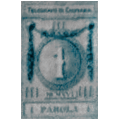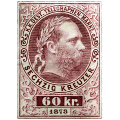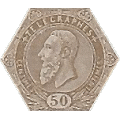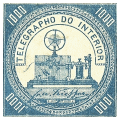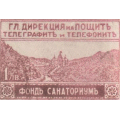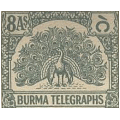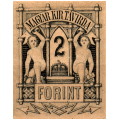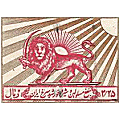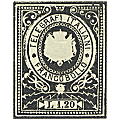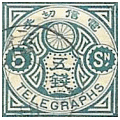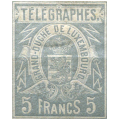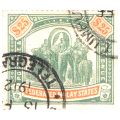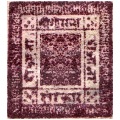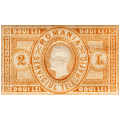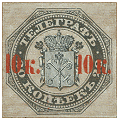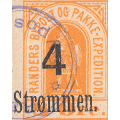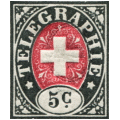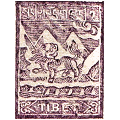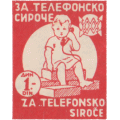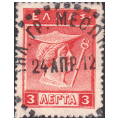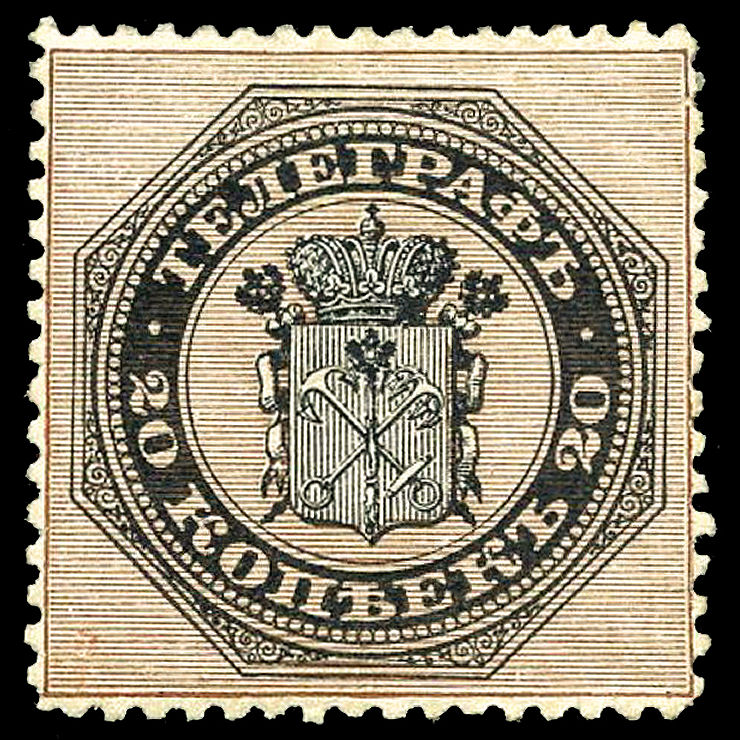| अनुवाद |
Übersetzen sie |
WORKING
|
Traduisez |
ترجم |
| перевести |
Traduca |
Traduzca |
翻译 |
|
Telegraph stamps of the World
Click here for a site-map. |
Select currency. Default = GBP (1.0)
|

I have brought these prices up to date and added currency selection.
I have made some additions and given them 'RH' (Revised Hiscocks) numbers to
preserve the original Hiscocks numbers.
CheckList Setup |
RUSSIA.
Steve Hiscocks wrote:
These stamps were sold only in St. Petersburg. The arms of which city they bear, and are thought to have been in use for a period of about two years.
They were available from the Town General Telegraph Office which stayed open until midnight each night. It would seem that few of the un-surcharged
stamps came into hands of the public since this is amongst the rarest of telegraph stamps.
The Russian state telegraph network, (9,000 km in total) was built between 1853 and 1855 by Siemens & Halske.
1866 (22 May) Typographed. White wove paper without watermark. Perf. 11¾
These feature the Arms of St Petersburg and were in sheets of 35 (5 rows of 7). The background frame was 27.5x27.5 mm.
St Petersburg used standard forms for 40 kopek that were good for up to 20 words.
Beyond that, these stamps could be added at 20 kopek for each 10 words.
They could also pay for multiple recipents or a return response.
In 1867 the cost was halved and the stamps were overprinted for 10 kopeks.
The stamps were withdrawn at the end of 1868.
Anyone have an example of one of those forms?
Proofs were stamped "ОБРАЗЕЦЪ" at an angle across several stamps at a time in red across the entire sheet.
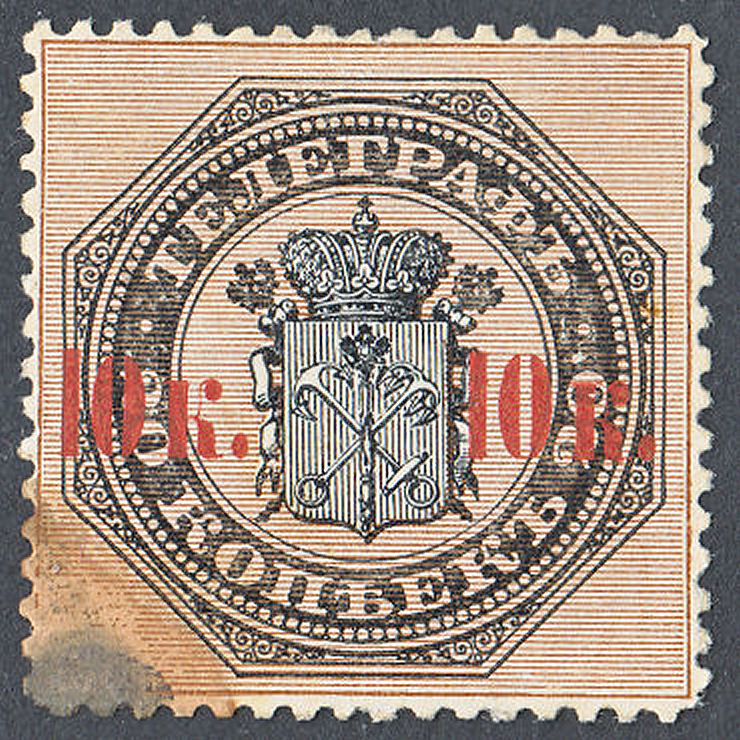 |
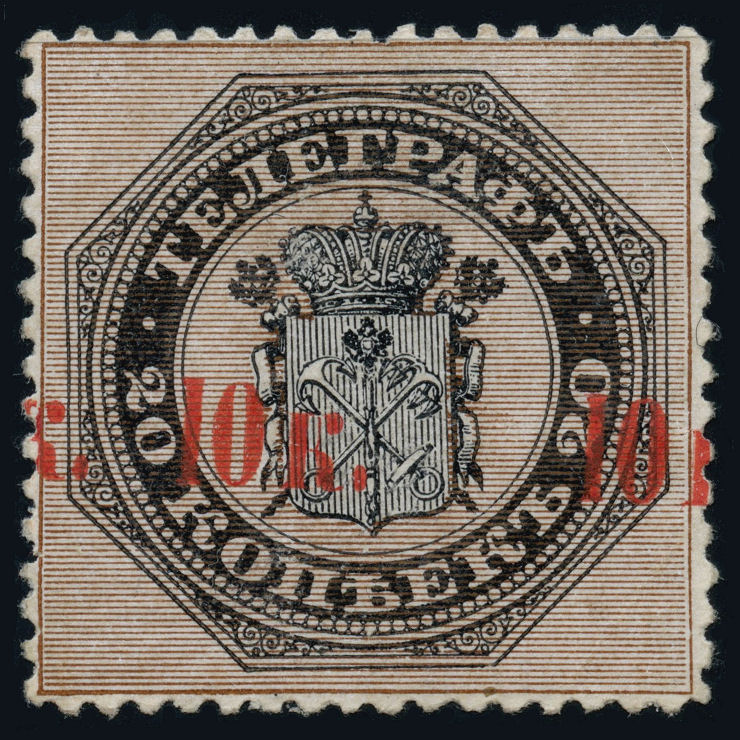 |
| RH2 (one of mine, 600dpi). According to Russia catalogues, the overprint was typographed. |
*RH2b with shifted overprint - courtesy of Andrew Farberov. (600dpi) |
|
The position of the black printing relative to the brown is variable, even within the same sheet.
This is because, whilst the rectangular brown rectangles are reasonably well aligned with each other,
the black octagons are not so well aligned.
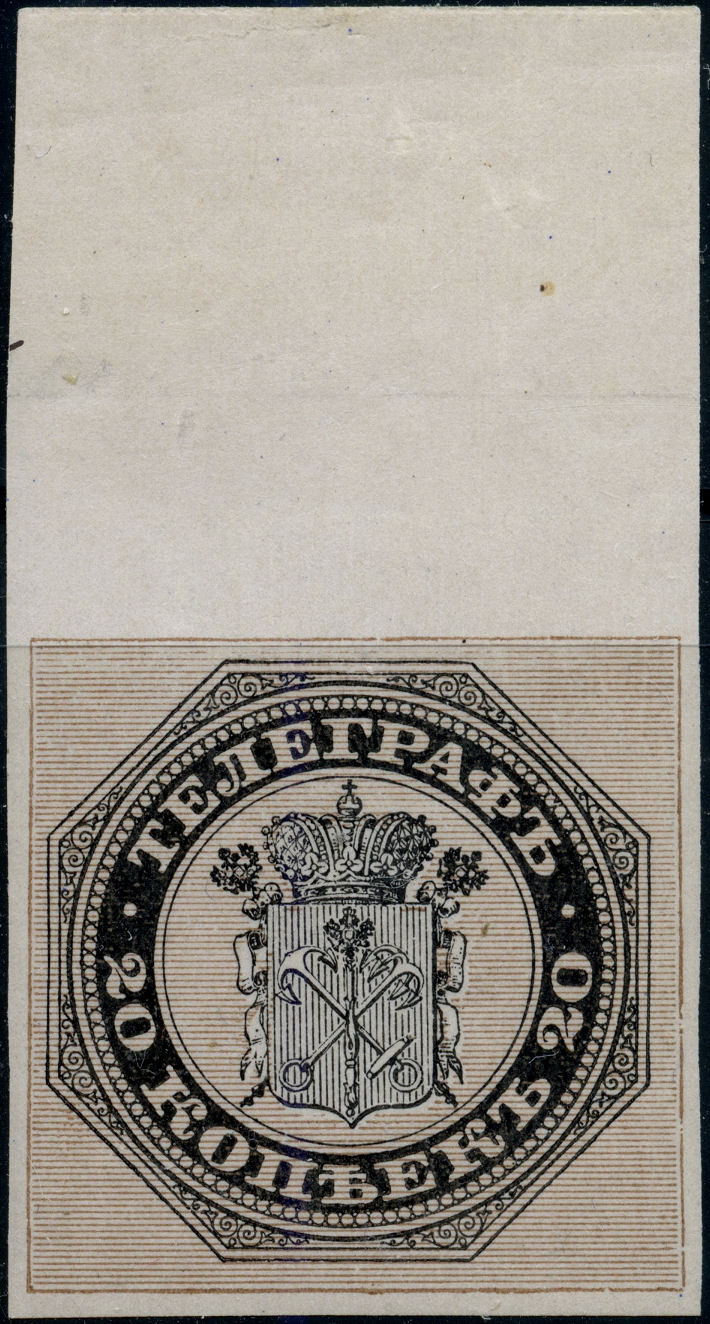 |
An example of RH1b with wide selvedge at the top. This width of selvedge was around all sies of the reprinted sheet.
Courtesy of Andrew Farberov. (600dpi) |
|
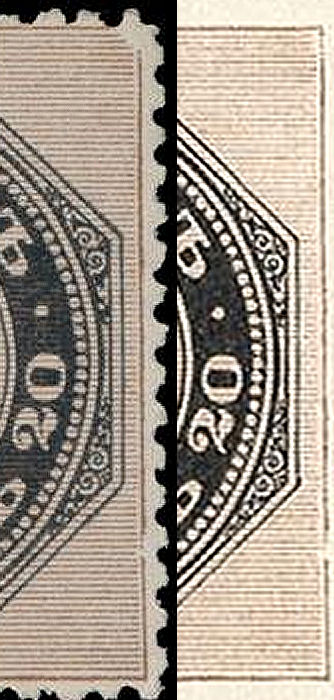 |
| RH # |
Hisc. |
Description |
Mint |
Used |
| RH1 |
H1 |
20 kopeks brown and black |
5000.00 |
- |
| *RH1a |
- |
missing corner |
6000.00 |
- |
| RH1b |
H1a |
imperf. (November 1881 Reprint) |
250.00 |
- |
| *RH1c |
- |
re-perforated reprint (see below) |
250.00 |
- |
| RH2 |
H2 |
10k surcharged in red on No. 1 (3.12.67) |
500.00 |
- |
| *RH2a |
- |
missing corner |
625.00 |
- |
| *RH2b |
- |
shifted overprint |
625.00 |
- |
* I have added these due to the information from Russian sources.
Hiscocks added the following note:
Note. No. 1(a) is listed by Morley as a genuine stamp but the evidence points
to its being a reprint. |
Russian catalogues list a variety of the top-right corner of
the last stamp on the top row (position 7).
It exists on H1 and H2, but is not known on H1a.
Possibly something was stuck to the plate and the
plate cleaned before the reprints were made.
Image at left courtesy of Andrew Farberov.
|
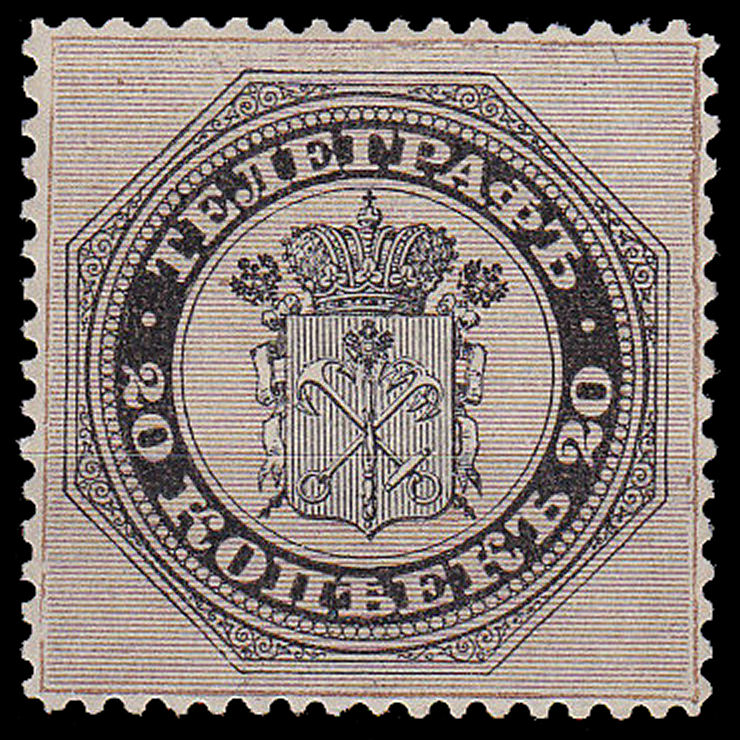 |
An example of *RH1c that is described as a reperforated reprint. Image courtesy of Peter Bernard. (600dpi)
This is distinctive enough to identify the sheet position (15, first stamp on third row) due to the dot and frame thickening. |
|
How do you recognise a reperforated reprint ?
John Barefoot says "beware imperfs. with forged perforations", but how do you recognise them?
Credit to Peter Bernard, that he describes his stamp as being just that and tells me that he showed it to 'an expert'.
If he had simply offered it for sale as a Russian Telegraph stamp, how much would you have bid?
As you would expect, the best source of information is on Russian websites.
skandinav.eu and
stamps.ru have provided the missing information.
The original stamp was produced perforated in 1866 and subsequently overprinted in 1867.
These were Typographed, with the black part printed first, followed by the brown background lines.
In this way, the brown lines are on top of the black, and thus visible.
In 1881 imperforate reprints were made. These were printed in "reverse order", with the brown
background printed first, then the black. Because of this, brown background lines are not visible on the black areas.
Subsequently, people have added perforations to some of the reprints to make them look like the original issue.
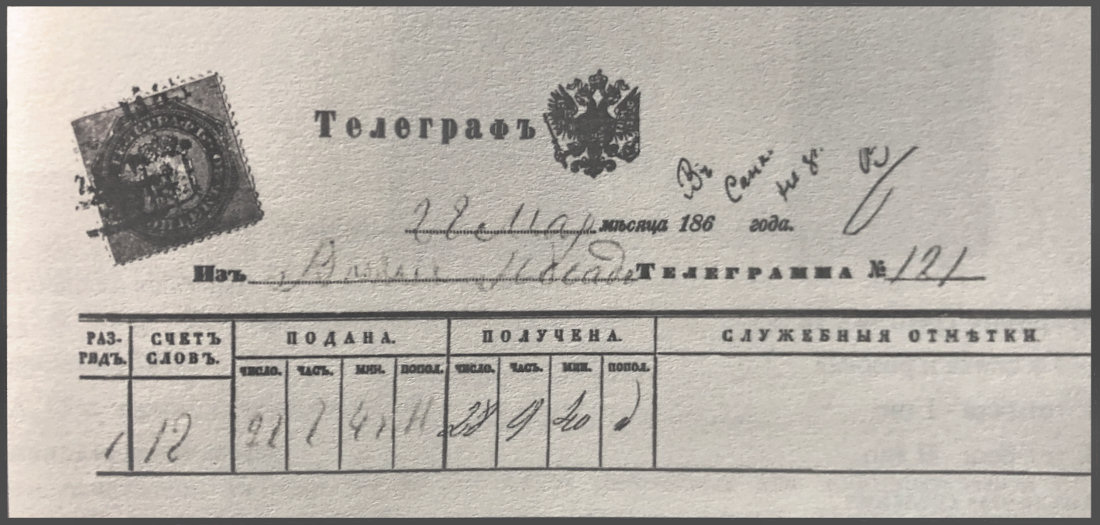
This is an image of a rare, if not unique used telegram bearing a 20k stamp. I think it is from a catalogue by Nikolay Mandrovsky, but have been unable to find contact details.
I show it anyway because it is an important item. The copyright holder is invited to get in touch. I would be happy to acknowledge them, with a link to their site. (I would also be happy to get a better image).
Правообладателю предлагается связаться с нами. Я был бы рад поблагодарить их, снабдив ссылкой на их сайт. (Я также был бы рад получить изображение получше).
Later, normal postage stamps were used.


A 1 kopek and 14 kopek of the 1889-92 issue, with telegraph cancels
of 1888 and 1891 respectively, both used in Saint Petersburg - from RL.

A strip of three 3 kopek of the 1909-12 issue, with telegraph cancels of 1910 applied at
Екатеринб(ург) or Ekaterinburg, gateway to Siberia, re-named Sverdlovsk in 1924 - from RL.
But things are not always as they seem.
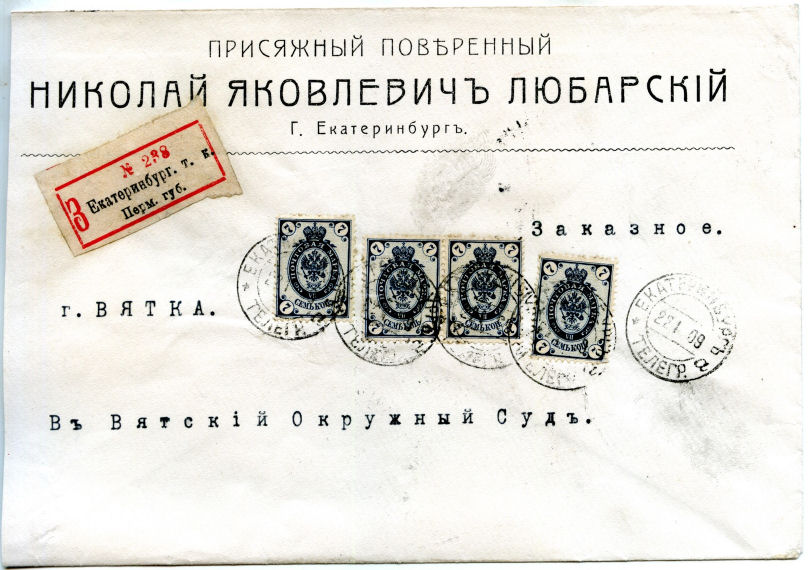
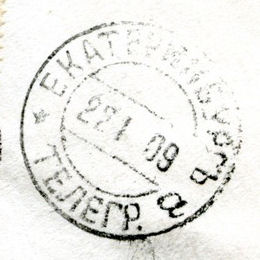

This is a registered letter from an Attorney in Ekaterinburg to the District Court in Vyatka/Bятка (now Kirov/Киров),
showing the telegraph cancel on the front and the back-stamp. This is dated 22 January 1909.
Though the offices involved may have handled both mail and telegraphs, this was sent by mail.
Images courtesy of Sergey, trading as philocartist on Delcampe.
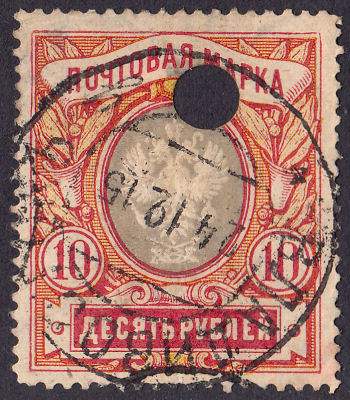
This is a 10 Ruble stamp used in Vladivostok 24 December 1915 with a punch-hole cancel.
This is one possible way in which they were used.
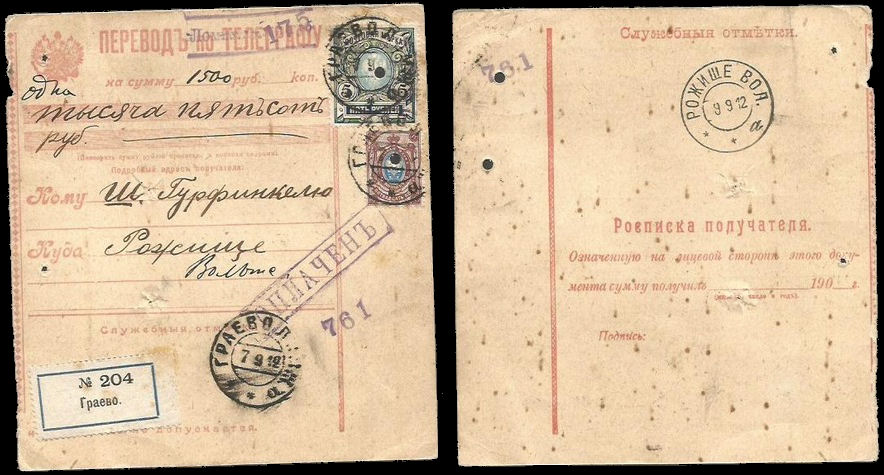
These were used to transfer money by Telegraph'. This transferred 1500 Rubles in 1912 from
Grajewo (now in Poland) to Rozhysche (now in Ukraine) at a cost of 5 Ruble, 15 kop.
Similar to the 10 Ruble above, though smaller, there are punch-holes in each stamp.
Image courtesy of Antonio Torres on (click image for Delcampe listing).
A similar item, but for a transfer by post in 1914 and without punch-holes, can be seen at POSTAL HISTORY OF LITHUANIA.
That was a cheaper method of transfer, though slower.
Turkey appears to have used a similar system, though the stamps were sliced rather than punched. |
Useful translations:
ПЕРЕВОДъ ПО ТЕЛЕГРАФУ - TRANSFER by Telegraph
Кому - Whom
Куда - Where
ОПЛАЧЕНъ - PAID
Граево. - Grajewo (town now in north-eastern Poland with 23,302)
Служебнын отмѣтки - Service mark
РОЖИЩЕ - Rozhysche (now in Ukraine)
Роеписка получателя - The receipt of the recipient
|
Receipts.
A range of receipts were used, some with decorative borders.

St. Petersburg to Leipzig 1899. - From RL

Riga to Leipzig 1901. - From RL
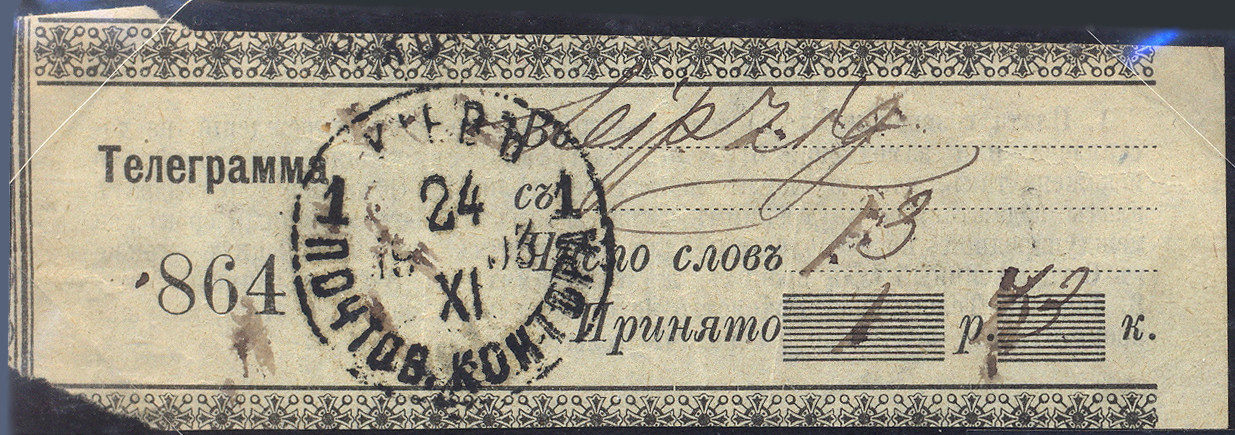
Kiev to Leipzig 1903. - From RL
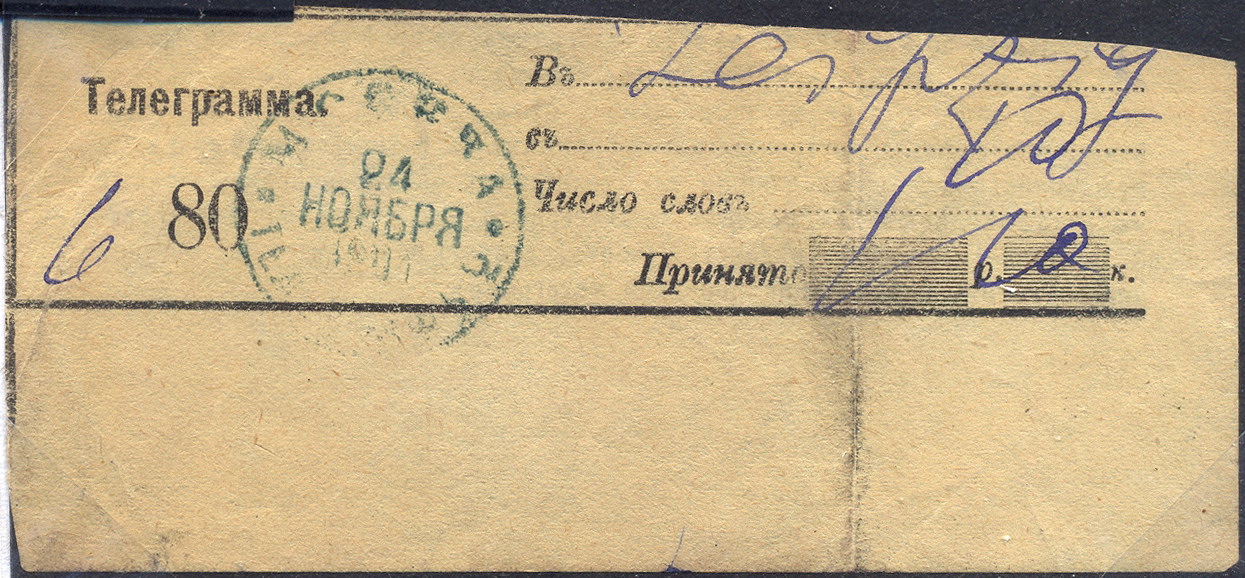
Moscow to Leipzig 1904. - From RL
Railway Telegraph Receipts.
Telegram receipts were also provided by the Siberian railways.
'ТЕЛЕГРАФЪ СИБИРСКОй ЖЕЛҌЗНОй ДОРОГИ'
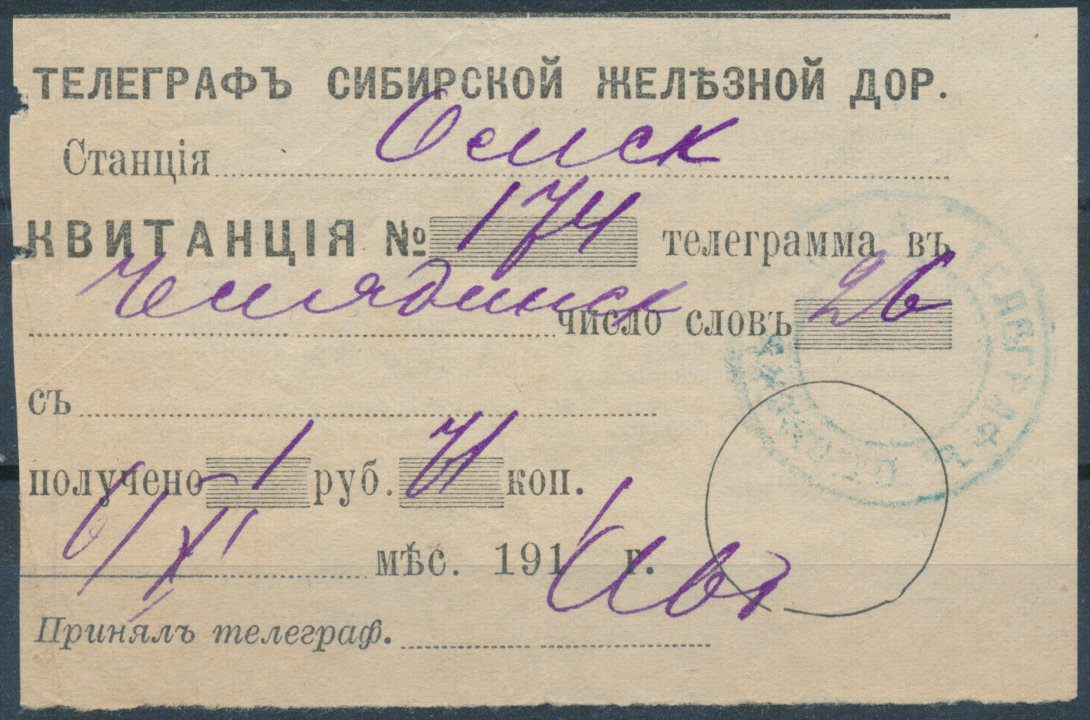
Omsk 1911. - Courtesy of Stamps2277 on eBay.
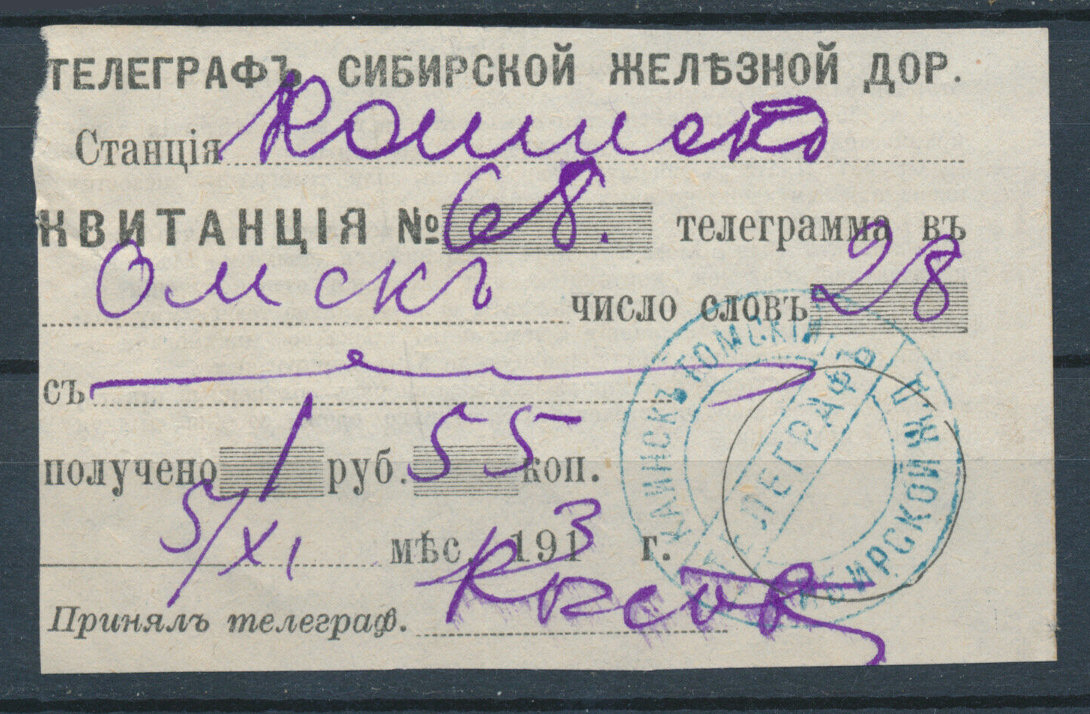
Kainsk, Tomsk Governorate, from Omsk, 1913. - Courtesy of Stamps2277 on eBay.
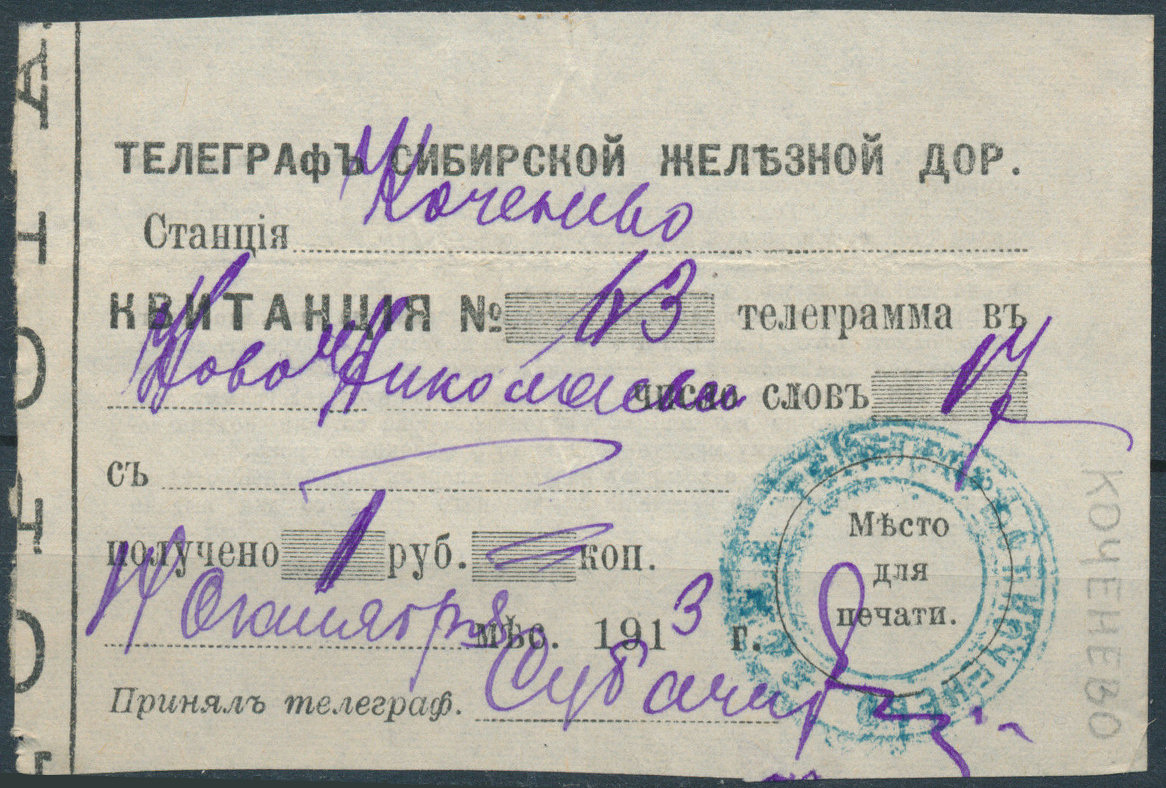
Kochenevo from Novonikolayevsk (now Novosibirsk), 1913. - Courtesy of Stamps2277 on eBay.
This has an added 'Мѣсто для печати'.
This is the back of it:
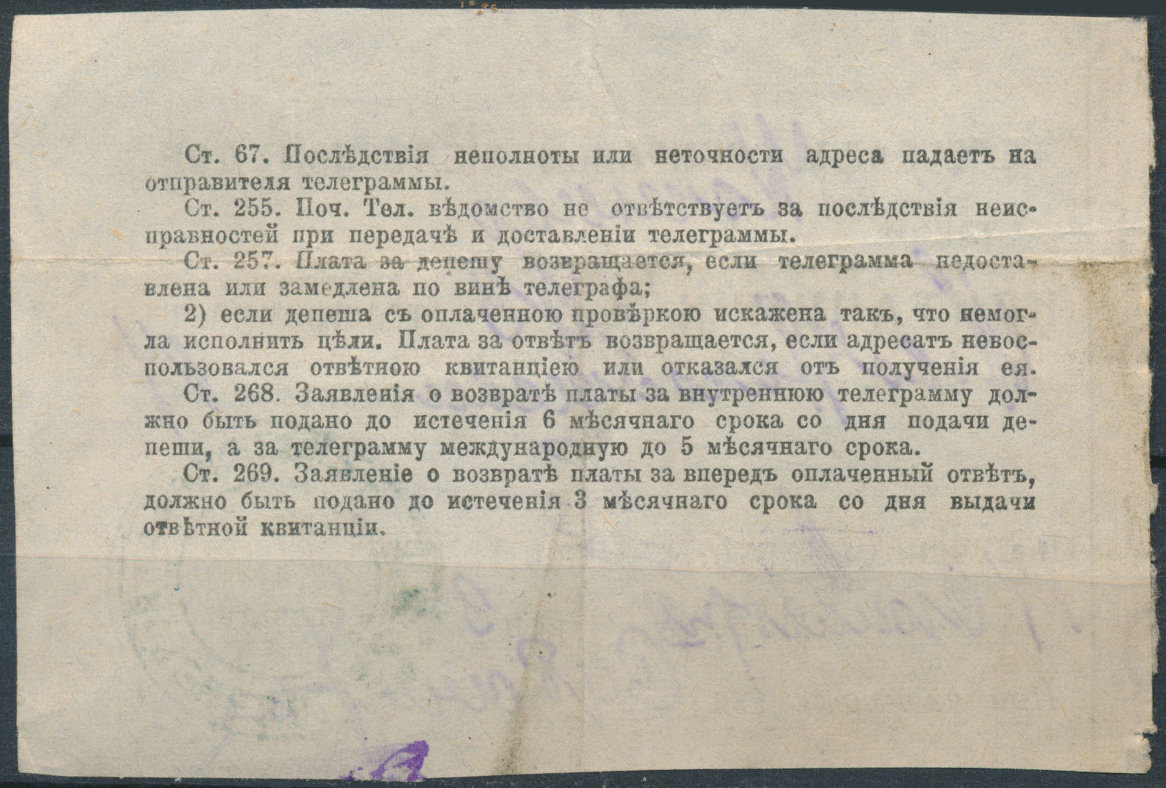
The same is on the back of the others. - Image courtesy of Stamps2277 on eBay.
Ст. 67. Послѣдетвiя неполноты или неточности адреса падаетъ нa
отправителя телеграммы.
Ст. 255. Поч. Тел. вѣдометво не отвѣтствуеть за послѣдствiя неис-
правностей при передачѣ и доставленiи телеграммы.
Ст. 257. Плата зa депешу возерощается, если телеграмма недоста-
влена или Замедлена по винѣ телеграфа;
2) если депеша съ оплаченною провѣркою искажена такъ, что немог-
ла исполнить цѣли. Плата за отвѣтъ возвращается, если адресатъ невос-
пользовался отвѣтною квитанцiею или отказался отъ полученiя ея.
Ст. 268. Заявленiя о возвратѣ платы за внутреннюю телеграмму дол-
жно быть подано до истеченiя 6 мѣсячнаго срока со дня подачи де- .
пеши, а за телеграмму международную до 5 мѣсячнаго срока.
Ст. 269. Заявленiе о возвратѣ платы за впередъ оплаченный отвѣтъ,
должно быть подано до истеченiя 3 мѣсячнаго срока со дня выдачи
отвѣтной квитанцiи.
|
Art. 67. The consequence of incomplete or inaccurate address falls on
the sender of the telegram.
Art. 255. Posts &Telegraphs in addition, are not responsible for the
consequences of failure of transmission and delivery of telegrams.
Art. 257. The payment for the dispatch is refunded if the telegram is
not delivered or is delayed due to the fault of the telegraph;
2) if the dispatch with a paid reply is distorted so that it could not
fulfill the objectives. The payment for the answer is refunded if the
addressee did not use the answer receipt or refused to receive it.
Art. 268. Applications for a refund of payment for an internal telegram
must be submitted before the expiration of 6 months from the date of
submission of the dispatch, and for an international telegram - up to 5 months.
Art. 269. Application for the refund of the payment for the advance paid answer,
must be filed before the expiration of 3 months from the date of issue of the
response receipt.
|
Telegram Seals.
This is said to be an Official Post Office letter of 1890 (sorry, I'm rubbish at reading Russian handwriting).

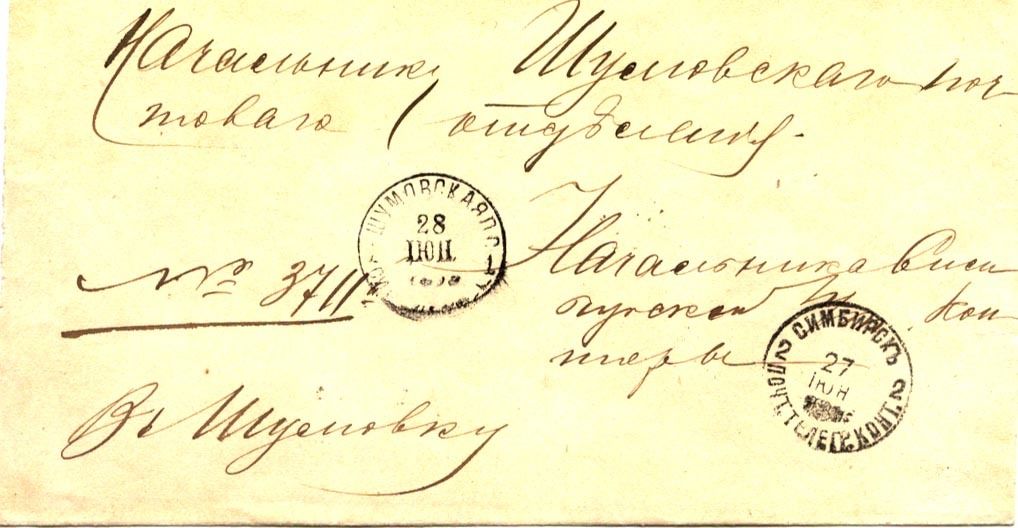
It has a 27 June Circular date stamp saying "СИМБИРСКъ ПOЧT. ТелегР. КОНТ." (Simbirsk Posts [&] Telegraph Control[?]),
and a 28 June CDS which is hard to read but with perhaps "ШУМОВСКАЯ П.С." (Shumovskaya, Ulyanovsk region)
Simbirsk (Симби́рск), is the birthplace of Vladimir Lenin (originally named Ulyanov), Simbirsk was renamed Ulyanovsk in 1924.
Images courtesy of Anatoly of toluki on eBay (click image for listing)..
This is dated June 1897 and has a seal of the Penza post-telegraph administration (ПEHЗEHCKAГO ПOЧTOBO-TEЛEГPAфHAГO OKPУГA.)
again with 'для писемъ' at the bottom meaning 'for letters'.
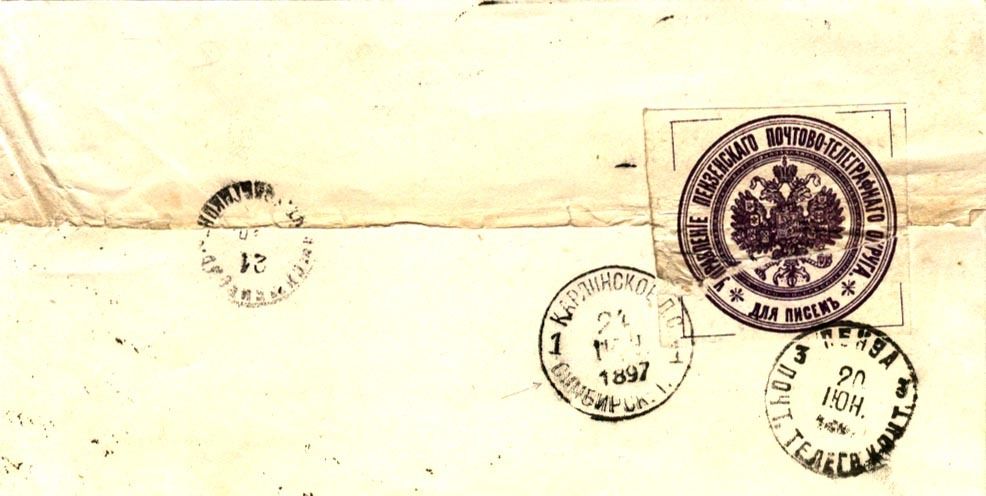
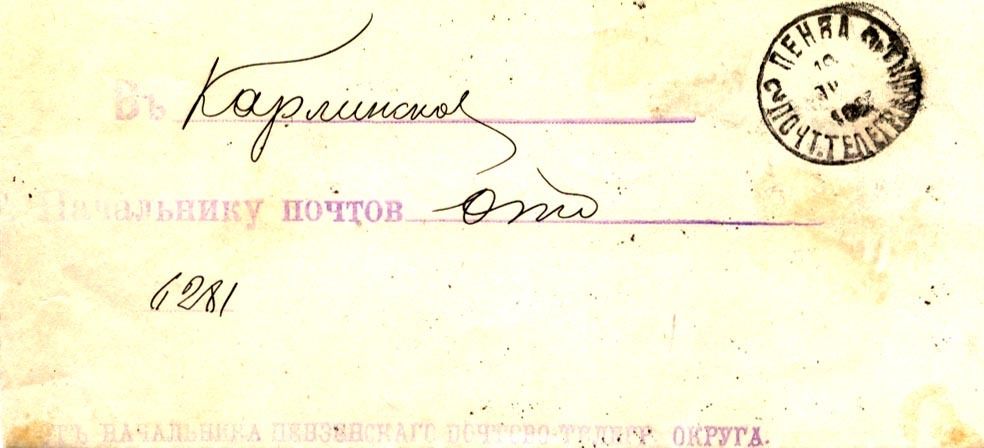
It is from Penza (Пенза) about 625km Southeast of Moscow (next to Simbirsk, see above) to Karlinskoye (Карлинское) near
Ulyanovsk (Ульяновск, then Simbirsk) about 893km east of Moscow.
Images courtesy of Anatoly of toluki on eBay (click image for listing)..
This item is interesting.
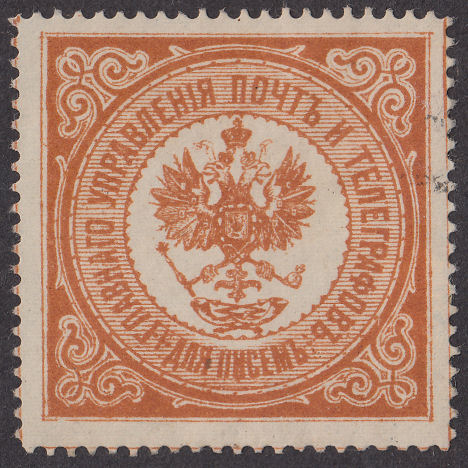
It is for post or telegraph use, 'для писемъ' at the bottom means 'for letters'.
The writing on the left uses obsolete script. The closest I can get is 'Главная Управление' meaning 'Main management'.
In the days of the Russian Empire, seals were provided for places now part of other countries.
This is a similar one to the last, - from RL
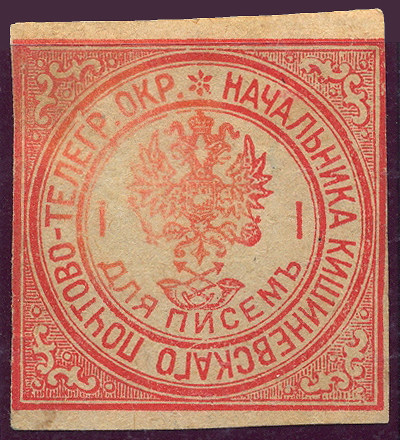
it is inscribed 'НАЧАЛЬНИКА КИШИНЕВСКАГО ПОЧТОВО-ТЕЛЕГР.ОКР.' which translates easier as:
'НАЧАЛЬНИКА КИШИНЁВСКАГО ПОЧТОВО-ТЕЛЕГРАФНОГО ОКРУГА' which means:.
CHIEF OF THE CHISINAU POSTAL-TELEGRAPHIC DISTRICT
Chisinau, or Chișinău is the capital city in what is now the Republic of Moldova.
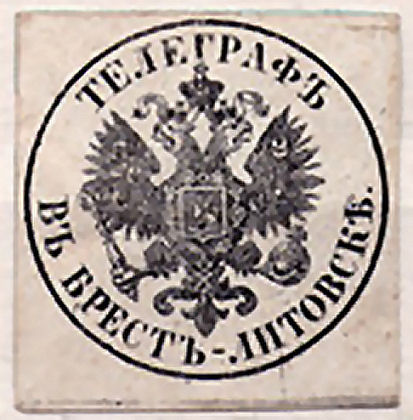 |
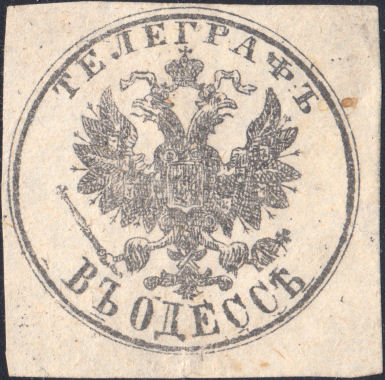 |
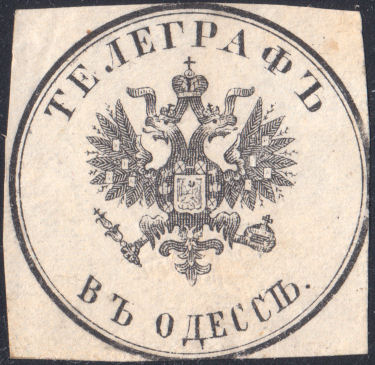 |
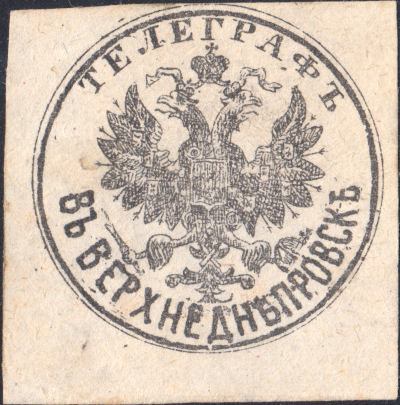 |
| For Brest-Litovsk, now in Belarus. |
For Odessa, now in Ukraine. |
For Odessa, now in Ukraine. |
For Verkhnedneprovsk,
now Dnepropetrovsk Oblast, Ukraine. |
This is another interesting item.
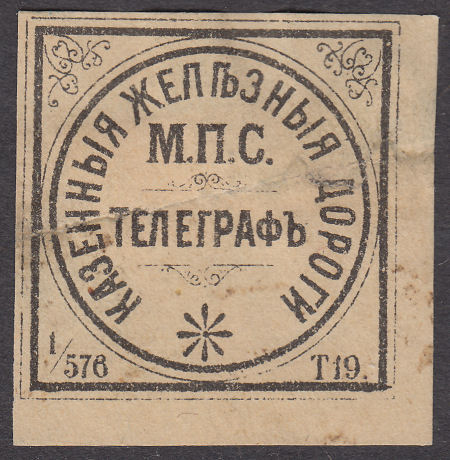
The 'МПС' in the middle stands for Министерство путей сообщения meaning 'Ministry of the Means of Communication',
effectively the Ministry of Railways (founded in 1865). Below that is 'Telegraph' and the wording around the edge
in modern script, 'Казения Железния Дороги' means 'State railways'.
The writing though is rather old-fashioned.
Steve Hiscocks made a start on cataloguing seals of the world in a book he published in 2007.
It was his hope to update it later, but unfortunately that was not to be.
His original book can be viewed at
Telegraph Seals: A World Catalogue. There are links from the pages to my updates.
Alternatively you can view the latest page for Russia.
Help would be welcome from anyone familiar with Imperial Russian.
Comments, criticisms, information or suggestions are always welcome.

Please include the word 'Telegraphs' in the subject.
Last updated 25th. March 2024
©Copyright Steve Panting 2012/13/14/15/16/17/18/19/20/21/22/23/24 except where stated.
Permission is hereby granted to copy material for which the copyright is owned by myself, on condition that any data is not altered and this website is given credit.


